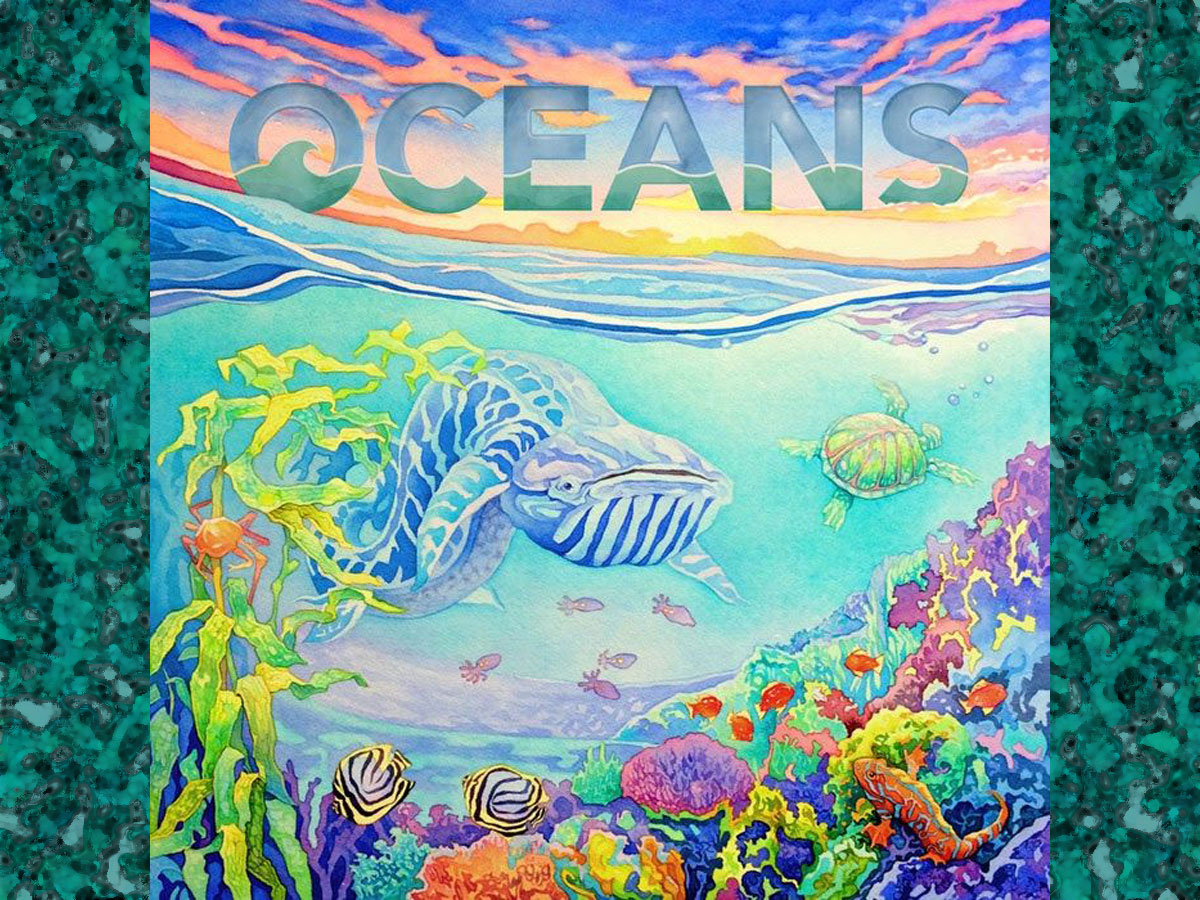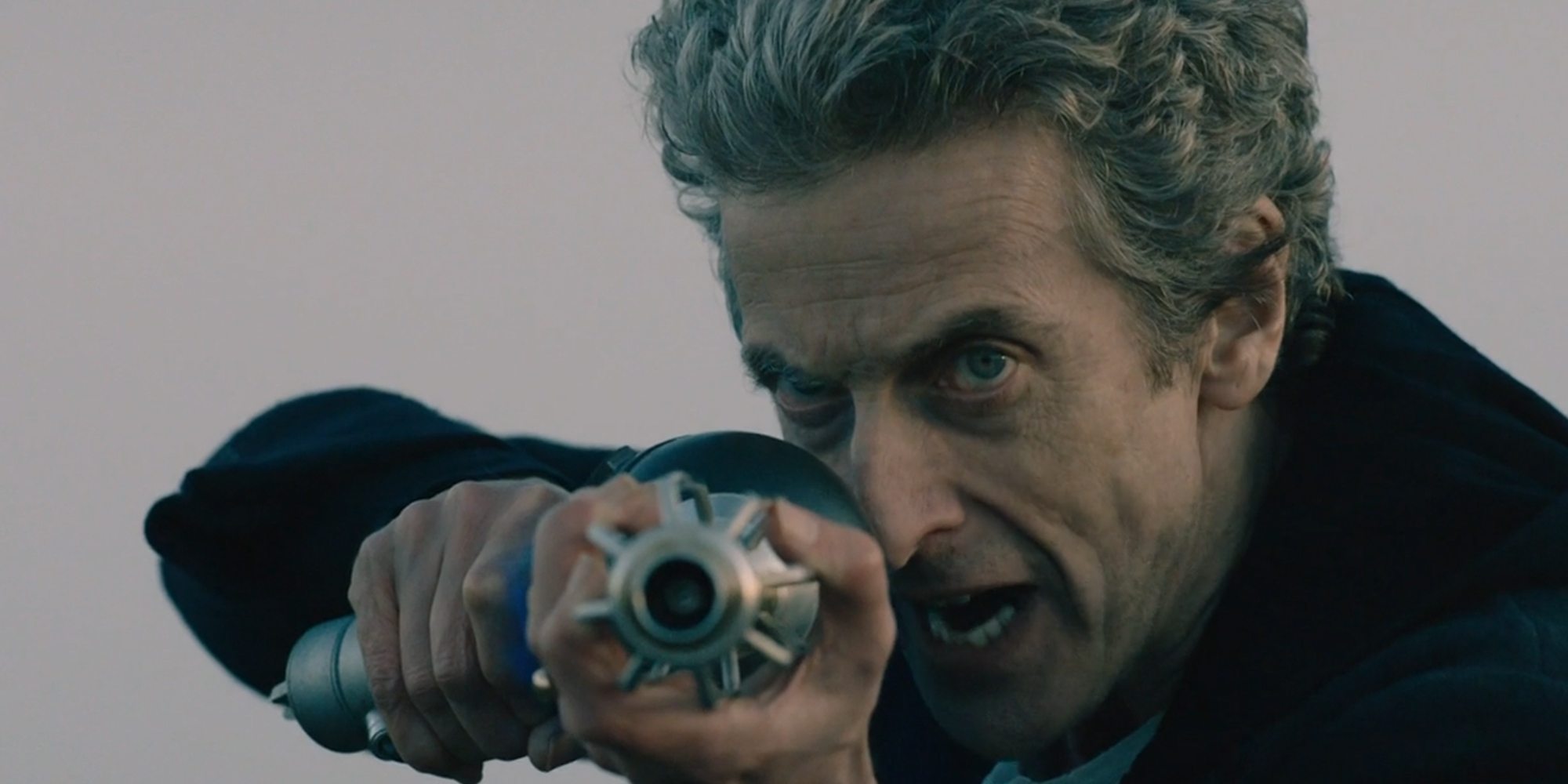Legendary figures and mythical creatures make their appearance in Oceans, bringing powerful, game-changing effects.
Disclosure and Explanation
Oceans was originally funded on Kickstarter in 2019 and published in 2020. I had been a fan of the Evolution series of games, and NorthStar Game Studio recruited me to edit the rulebook for Oceans. As it turned out, there was a lot of ongoing development as things were finalized, and even some tweaks that were made to the rules between my Kickstarter Tabletop Alert and the finished version. NorthStar is launching a new campaign for an expansion, Legends of the Deep, but I wanted to take the time to do a thorough explanation of the finished game as well since my original rules explanation is no longer up to date. Since I got paid to work on Oceans, I’m obviously biased; I do not have any involvement with Legends of the Deep.
What Is Oceans?
Oceans is a game for 2 to 4 players, ages 12 and up, and takes about 60–90 minutes to play. The standard game retails for $54.99 and the deluxe edition is $84.99; both are available directly from NorthStar Game Studio, but I believe retail stores will only have the standard version. The gameplay can be pretty deep (ahem), but there are variants for less experienced players to ease you into the depths. Although Oceans is in the Evolution series of games, it’s a stand-alone and does not combine with the other Evolution games.
Oceans was designed by Nick Bentley, Dominic Crapuchettes, Ben Goldman, and Brian O’Neill, and published by NorthStar Game Studio, with illustrations by Catherine Hamilton, Guillaume Ducos, and many other artists who are credited individually on each Deep card.
Legends of the Deep is an expansion for Oceans. It is currently seeking funding on Kickstarter, with a pledge level of $23 for a copy of the game. There’s also a $85 pledge level that includes the base game with the expansion, and the campaign also has a new solo expansion available for $17. Legends of the Deep was designed by Dominic Crapuchettes, with illustrations by a long list of artists, credited on each card.
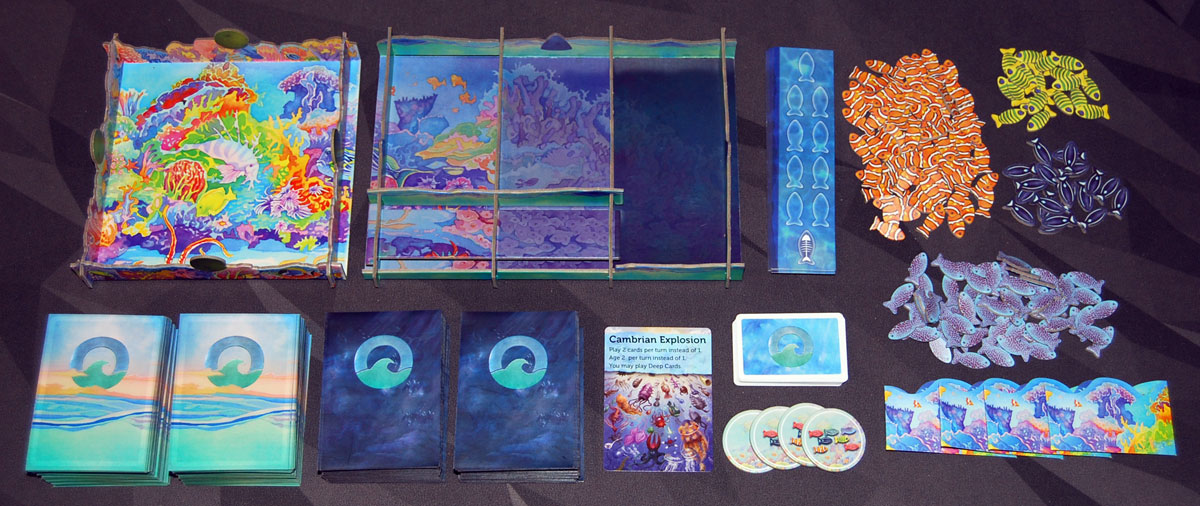
Oceans and Legends of the Deep Components
Here’s what comes in the box for Oceans:
- Reef tray
- Ocean tray
- 24 Species Boards
- 120 Surface cards (10 of each type)
- 89 Deep cards
- Cambrian Explosion card
- 25 Scenario Cards
- 4 Bonus Score tokens
- 200 Population tokens in 4 colors
- 4 Player screens
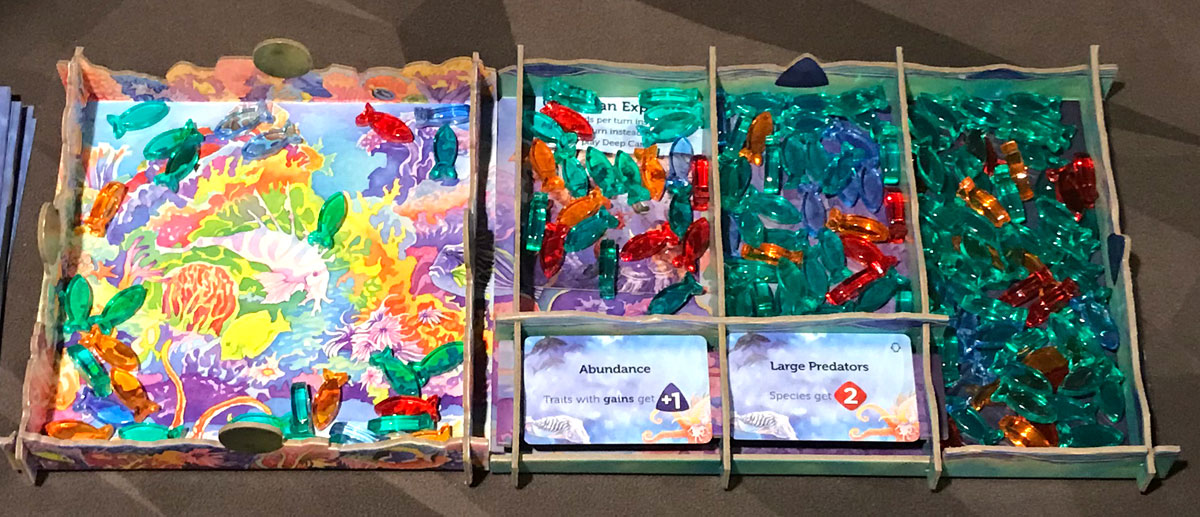
The Reef and Ocean boards are shallow boxes, designed to hold the population tokens in their various piles, with spaces to place the two scenario cards. The first Ocean slot is also designed to hold the Cambrian explosion card, with an opening at the top of the tray so you can slide the card out easily (instead of having to pick it up inside the tray). One nice touch is that the Reef tray is marked with a green circle and the Ocean tray is marked with a blue triangle, corresponding to the “forage” and “gain” icons on the cards, to show you where to take tokens from. While the trays are helpful to keep the piles of fish tokens separate from each other (the prototype just used individual flat boards), it can be a little difficult to grab the last layer of fish tokens from the tray, and the tokens are small enough that they can hide along the walls. (Camouflage works!)

The fish tokens are small cardboard tokens—they’re have the stereotypical fish silhouette, but are printed with different patterns. The particular patterns you use will depend on the number of players, and makes it so you don’t have to count the fish but just group them by type. The deluxe edition included acrylic fish, which are also fun to look at but are solid translucent colors rather than the illustrated look of the cardboard tokens.
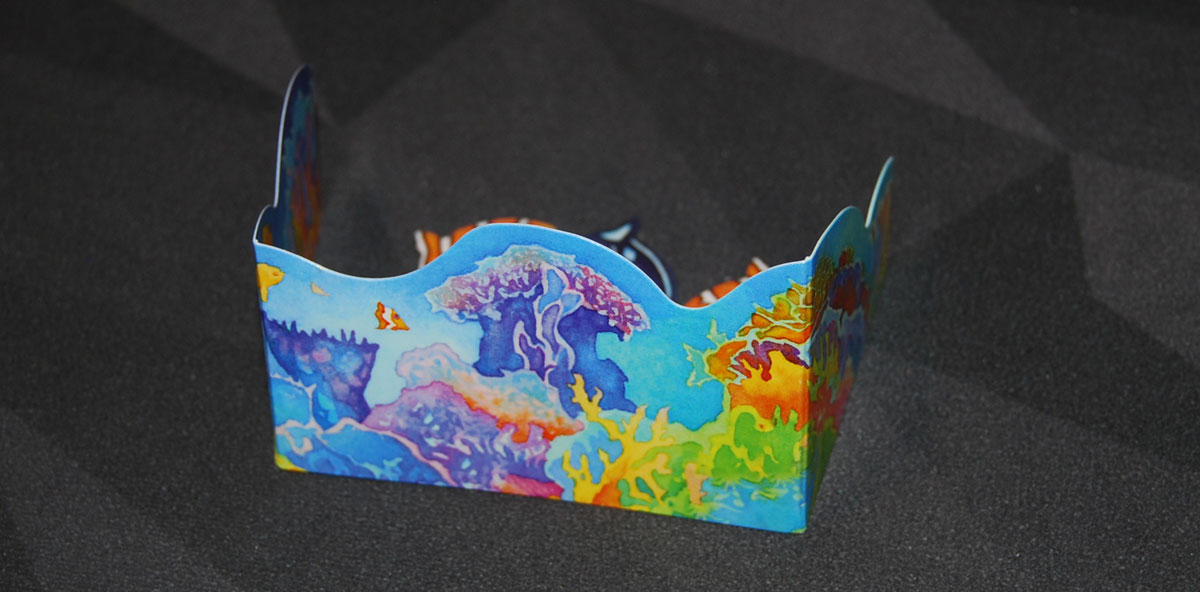
The player screens feature the artwork of the reef, and are used to keep your score pile hidden from the other players. They’re pretty tiny, though, so I do prefer the cloth bags used in the deluxe edition. They work, but you do have to keep them back a bit from other players to prevent them from seeing over them.
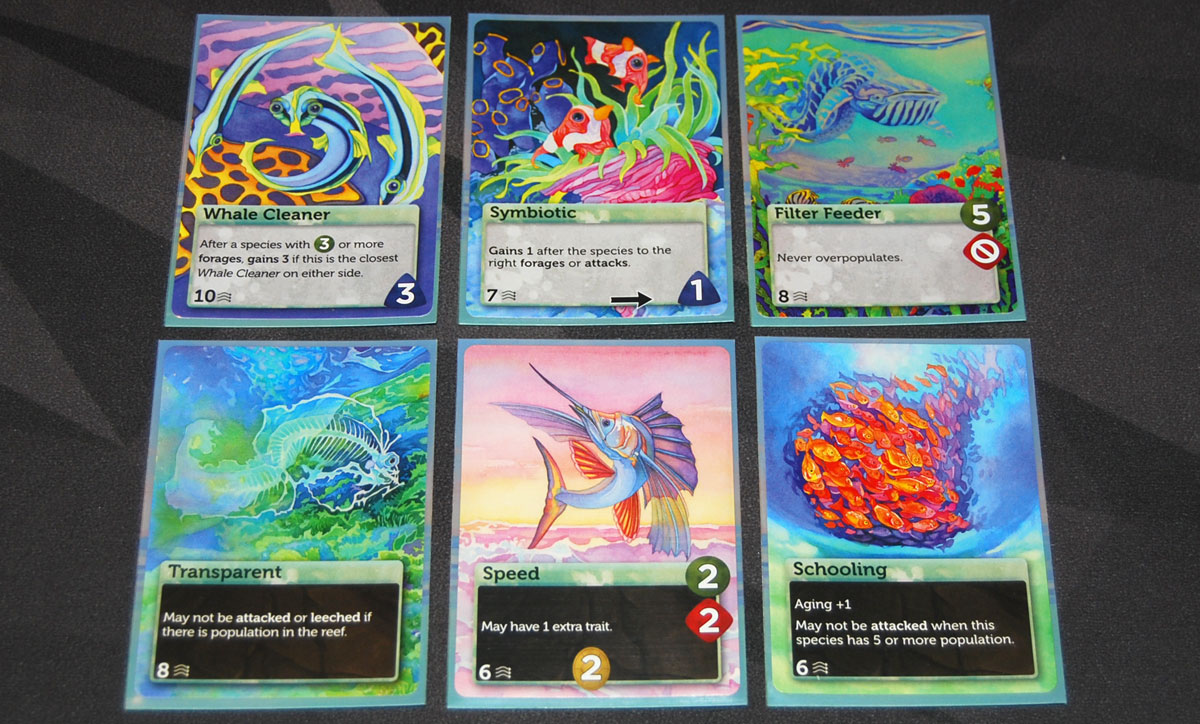
The game features artwork by Catherine Hamilton, who also did the watercolor illustrations for the Evolution series, as well as additional artwork from Guillame Ducos and other artists for the many Deep cards—and since each Deep card is unique, that’s a lot of art. I really love the way this game looks, from the colorful Reef and fish tokens to the wild and imaginative creatures found in the depths.

Legends of the Deep consists of a deck of oversized cards—the prototype I received has 24 cards, but I don’t if that will change in the finished version. The cards look like the Deep cards from the base game, but much larger, with a card cost at the bottom and some text explaining the card’s ability.
How to Play Oceans
You can download a copy of the rulebook here.
The Goal
The goal of the game is to have the most population (in your score pile and on your surviving species) by the end of the game.

Setup
Place the Reef and Ocean trays in a row, with two randomly drawn Scenario cards placed on the spaces on the first two ocean sections. Make a pile of population tokens (the colors used will depend on the number of players), and divide those roughly into four piles, placing one pile in each of the Reef and three Ocean sections. Set aside the 60 reserve population tokens—these will only be used in the last round of the game.
Shuffle the Surface cards, and flip the top card into the discard pile. There’s a small number at the bottom left called the Migrate number—move that many population from the first Ocean board into the Reef. Shuffle the Deep cards and turn the top 2 face-up as the Gene Pool. Set the species boards off to the side.
Deal 6 Surface cards to each player, and give each player a player screen. Each player also receives a bonus score token according to the turn order—the first player will get the biggest score bonus and the last player will get the least.
Gameplay
On your turn, you do the following:
- Play cards (evolve or migrate)
- Feed a species
- Age your species
- Draw cards
Play Cards
At the beginning of the game, you play 1 Surface card per turn to evolve or migrate. To evolve, you place it on a species (new or existing), with up to 3 traits allowed per species. You may have any number of species, arranged in a row in front of you. To start a new species, take a new species board and place the trait card next to it; your new species may be at either end of the row, or inserted between two existing species. To migrate, you discard a card and move the Migrate number of population from Reef to Ocean, Ocean to Reef, or Ocean to Ocean. (You can’t play Deep cards until the Cambrian explosion—see below.)
During this phase you’re also allowed to remove any number of traits from any of your species as a free action; Surface cards are discarded and Deep cards are removed from the game.

Feed a species
Pick one of your species—it may forage or attack. Foraging lets you take population from the Reef and place it on your species board, equal to the total of the green numbers on the forager. Attacking lets you take population from any other species on the table (including your own!), equal to the total of the red numbers on the attacker, though of course there are defensive traits that come into play. (If you have no green or no red numbers, you can forage or attack for 1.)
Some cards have blue “gain” icons on them, which may be triggered by various types of actions even when it’s not your turn. When you gain population, you take it from the first available Ocean pile, moving to the next pile if needed.
If you ever put a population on the last space of your species board (with the fish skeleton), then your species overpopulates—discard population to the Reef until you have 5 population left.
Aging
Every one of your species ages: take 1 population from each species and put it in your score pile, behind your screen. If any of your species is unable to age because it doesn’t have enough population, it goes extinct: discard the trait cards and return the species board to the supply. Should’ve eaten some more!
Draw Cards
You may draw 1 Deep card—either from the Gene Pool, or draw 3 from the deck and keep 1, placing the rest in the Gene Pool. Then you may discard any number of Surface cards, and then you draw Surface cards from the deck until you have 6 cards total. (Note that I haven’t explained how you can play Deep cards yet, but you can still start stockpiling them.)
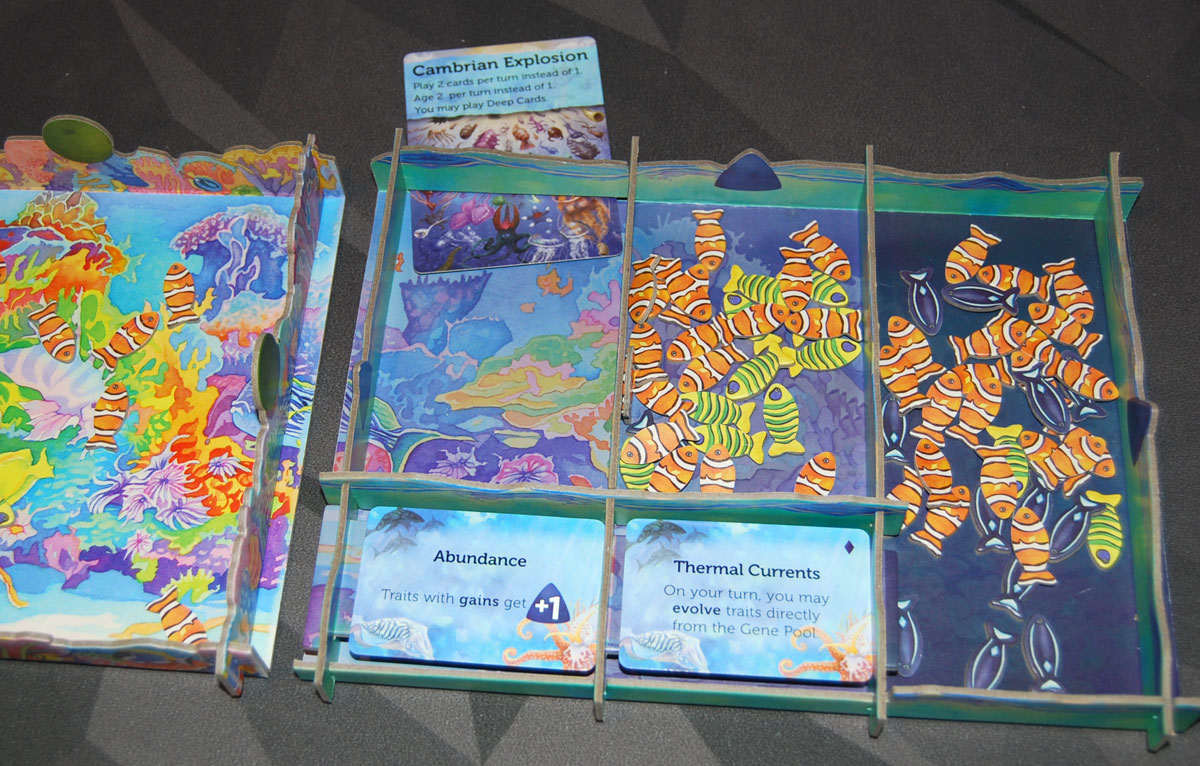
Cambrian Explosion
The first time the first Ocean zone is emptied, it kicks off the Cambrian explosion, which ramps up the pace for the rest of the game (even if that zone gains any population later). Slide the Cambrian explosion card out from the tray as a reminder. From now on, you play 2 cards per turn, and you may now include Deep cards in that. Also, you will age 2 population per species instead of 1 each turn.
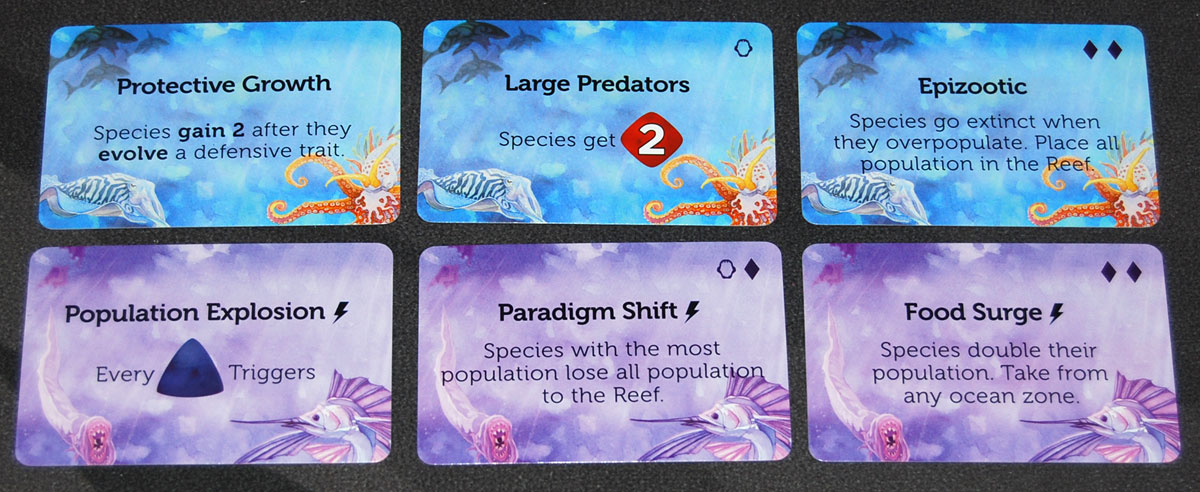
Scenario Cards
The two scenario cards on the Ocean boards will activate when their corresponding Ocean piles are empty (including when the Cambrian explosion is triggered). A few cards are immediate events, and others have ongoing effects. As population is migrated back and forth, the scenario card can be deactivated and reactivated over the course of the game.
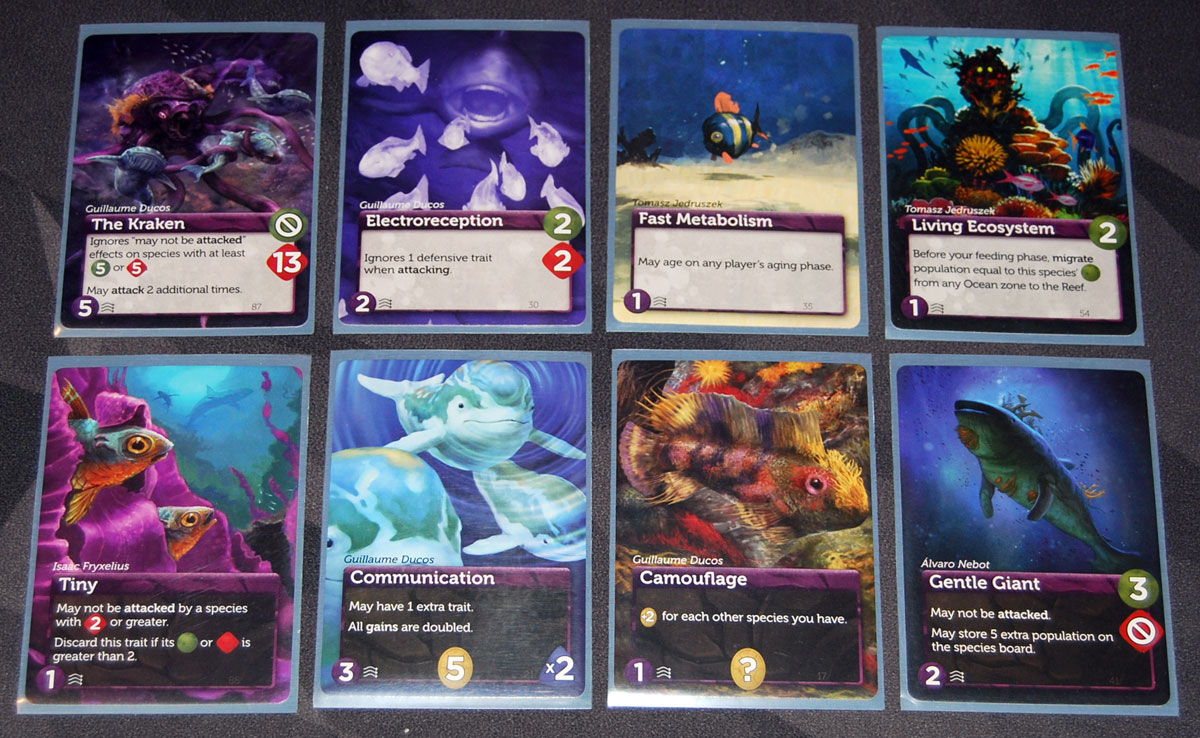
Deep Cards
Deep cards have a cost: you pay the cost from your score pile, placing the tokens into the Reef, an Ocean pile, or even the Reserve. Each Deep card is unique, and they have powerful and unusual effects: some may let you exceed the 3-trait maximum. Some might let you store more population on your board before you overpopulate. Some Deep cards aren’t traits, but are actually events, which take effect and then the Deep card is removed. (Deep cards are never placed into a discard pile; they’re removed from the game.)
You may also use Deep cards to migrate, in which case you don’t pay a cost. You just migrate population as usual, equal to the card’s cost.
Game End
The game end is triggered when the Ocean is completely empty (all three zones). Add the reserve population to the last Ocean zone and continue playing until the round is over (when the last player in turn order has completed their turn).
You score as follows:
- 1 point per population in your score pile
- 1 point per population on your surviving species
- Bonus points from your bonus score token
The highest score wins, with ties going to the most total trait cards on their species.
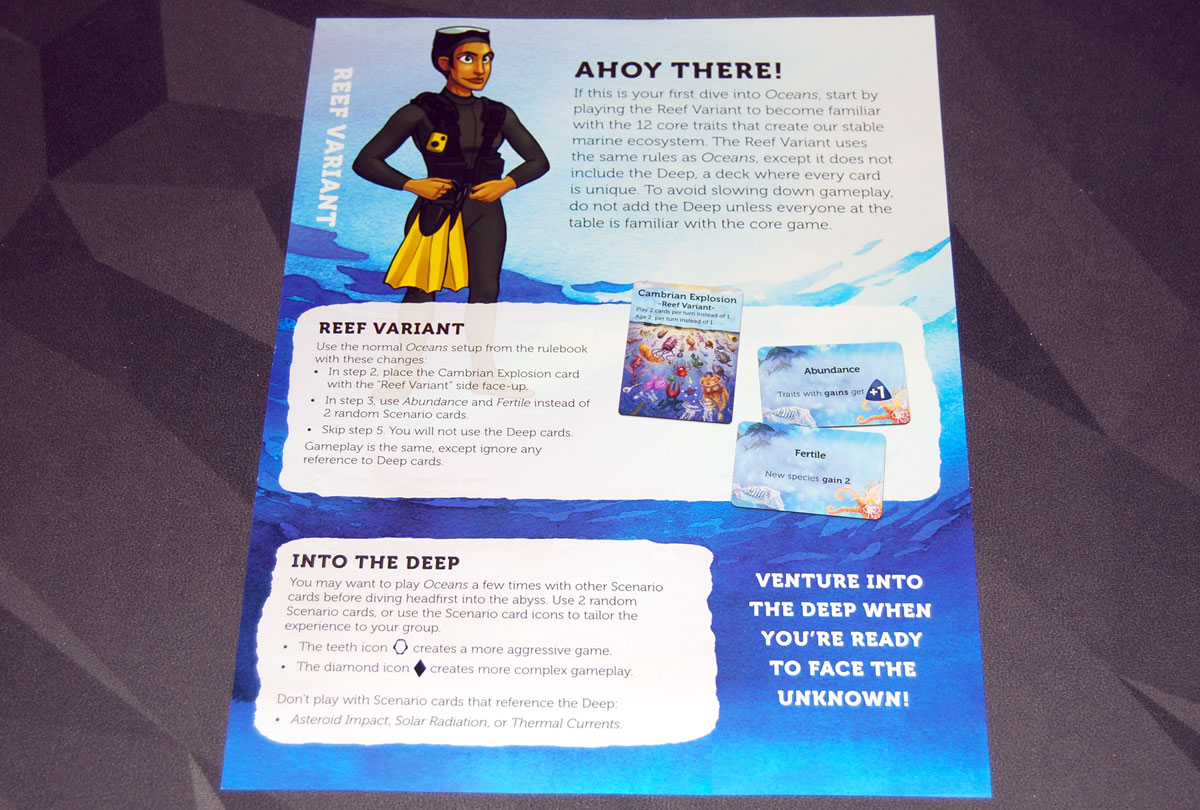
Variant Rules
There are a couple of variant rules for less experienced players: you can start without scenario cards and Deep cards, using just the Reef and a single Ocean pile. Then, introduce specific scenario cards that aren’t too complex. After that, try using randomized scenario cards. Finally, throw in the Deep cards and you’re playing the full game!
How to Play Legends of the Deep
Legends of the Deep has a surprisingly small rulebook, and it’s mostly details about each individual card. During setup, you shuffle the Legend cards and deal four to each player, and then players draft (pick-and-pass) until everyone has picked four cards.

On your turn, you may play a Legend card by paying the cost, just as you would a Deep card, but you’re not restricted to after the Cambrian explosion occurs. You may only have one Legend card in play at a time; if you want to play a different one, you return the current one to your hand and only pay the difference between the two (but no refunds if it costs less!).
Legend cards have various abilities but many of them affect all of your species. They do not count as trait cards (for any abilities that affect traits) but are otherwise kind of like adding the same Deep trait to all of your species at once.
The rest of the gameplay is unchanged.
Why You Should Play Oceans and Legends of the Deep
I’ve already written about how much I enjoy the Evolution board game: the Climate expansion was one of our Game of the Year finalists in 2017. So when Oceans was first announced in early 2017, I was eager to see how it would work. While I was a little surprised when I discovered that it was a standalone game and couldn’t be combined with earlier Evolution games, I like the way that the gameplay has been streamlined and simplified, while the potential card combinations has grown and become more complex.
In Evolution, players had to play cards to add food to the watering hole (a step that was often forgotten), then played cards to evolve their species, and then everyone took turns feeding their species until the food ran out. Each species had a size and a population, and you had to discard cards to increase those, plus discard a card to create a new species.
In Oceans, you no longer deal with separate size and population numbers, and there’s also no separation between population and food. Your species eats: it gains population. It gets eaten: it loses population. Also, on your turn, you only play 1 card (or 2 cards after the Cambrian explosion), and you only feed 1 species. The turn order becomes a lot simpler, because instead of having several distinct phases per round, players just take turns one after the other until the end of the game.

Where it gets more complex is in the card interactions. Since you only feed 1 species, but all of your species age and are at risk of extinction, you have to figure out how to build synergies to keep them alive. Play Symbiotic to let a species gain population whenever the one next to it feeds. Play Parasitic to leech population away from a neighbor. Whale Cleaners and Shark Cleaners can gain when species forage or attack with big numbers. The key is setting up chains that will gain population even when you’re not feeding, so that your species can survive aging and extinction. The more species you can keep alive, the more you score: one per species (or two after the Cambrian explosion)! Beginners will often try to create a few maxed-out species with lots of traits, but it’s important to remember that aging gives you points based on the number of species you have, not how strong one particular species is.
And then, of course, there’s the complications of attacks and defenses. In Oceans, every species is a predator by default: every species can attack or forage (barring traits that prohibit attacking or foraging). That means you have to start thinking about defenses: some cards just prevent you from being attacked if certain conditions are met; shell icons reduce the number of population you lose from an attack. Or, you can use some Bottom Feeders so that even if you do get attacked, the target’s neighbors benefit from it.
Once the Cambrian explosion occurs, the Deep cards enter play, and that’s where things really start to get wild. You can start drawing Deep cards from the beginning of the game, but that effectively reduces your hand size of Surface cards, since you can’t discard Deep cards you don’t want. However, those Deep traits can be extremely powerful, and with a deck of 89 unique traits, there are oodles of possible combinations. Bear in mind, though, that playing Deep cards costs you points—so you want to be sure that it’s worth the cost of playing them. I like the way that the game starts off more simply, so that you can start building up your species, before the Cambrian explosion dials it up.
The scenario cards are a fun environmental factor that will tweak the game a little each time you play. Some scenarios result in a much more aggressive ecosystem that encourages attacks. Others may make overpopulation more devastating. Because you can spend cards to migrate population, players have a little bit of control over the timing of scenario cards… but it’s only putting off the inevitable, because the game doesn’t end until the Ocean has been emptied. In some cases, a player may try to trigger a scenario sooner because their species are well-suited for it, and it will give them an advantage over other players.
Legends of the Deep adds a whole new pile of interactions and complexity: even though it’s a very small expansion and doesn’t add a lot of rules overhead, those 24 cards have outsized effects. I would recommend adding them only after everyone is pretty familiar with the base game, because even a single card can add a lot to keep track of. Most of the Legends cards start with the text “All of your species get the following” so it really does feel like adding several trait cards for the price of one—and powerful ones, at that. These are effects that on their own can feel completely overpowered… but then you realize they’re all like that. Because of the cascading effects, it can extend the length of turns and add a lot more to keep track of, which is why I generally wouldn’t break it out for new players.
While the original Deep cards do border on fantasy, they mostly try to give at least the pretense of being science-based: there’s so much we don’t understand about deep-sea creatures that you have some leeway there. The Legends cards, however, fully embrace the magical and fantastical. You’ll find mermaids and Greek gods, flying whales and actual dragons. Thematically it may seem like a strange direction for a game series that is so heavily rooted in science, but even scientists like to indulge in a little make-believe from time to time, I suppose.
If there’s a downside to Oceans, it’s that the depth of the game can be a little intimidating, and it can be unforgiving for new players. A key part of the strategy is knowing how to combine traits effectively, so familiarity with the 12 Surface traits definitely gives you an advantage. Experienced players will be able to create chains that feed several of their species efficiently, while newer players may struggle to keep more than two species alive round after round, and it can be difficult to catch up if somebody gets a substantial early lead. That said, the Deep cards can be game-changers, and I’ve seen combinations that led to enormous gains in a single turn. Like Evolution, Oceans is a game that rewards repeated plays so that you start learning the patterns and interactions.
I do really enjoy the puzzle-like aspect of building a group of species that work symbiotically. The varying ecosystem—based on what other players have, the state of the Reef and Ocean piles, and the scenario cards—presents a challenge to the players, who must find the best ways to adapt and survive. It’s fantastic when you discover a powerful combination, and then devastating when another player finds a way to circumvent your carefully crafted systems. Because there are so many Deep cards, there’s no guarantee that you can rely on the same combinations each time you play. Before the Cambrian explosion, you’ll see familiar patterns and systems, but then once the Deep cards enter play, all bets are off.
If you enjoyed Evolution, you’ll want to take a dive into Oceans for sure. If you’ve never tried any of the Evolution series of games, Oceans is also a great place to start (both mechanically and thematically)!
For more about Oceans, visit the NorthStar Game Studios website. To find out more about Legends of the Deep, visit the Kickstarter page!
Click here to see all our tabletop game reviews.
![]() To subscribe to GeekDad’s tabletop gaming coverage, please copy this link and add it to your RSS reader.
To subscribe to GeekDad’s tabletop gaming coverage, please copy this link and add it to your RSS reader.
Disclosure: I received a copy of this game. In addition, I was hired by NorthStar Game Studio to work on the rulebook, though I did not receive compensation for writing this review.
